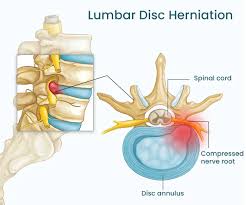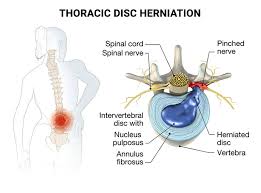As the nucleus pulposus losses turgor and elasticity the annulus decreases in size and the disc bulges outwards beyond the vertebral margins.
Herniation of the nucleus pulposus through an annular defect causes protrusion of disc material beyond the margin of adjacent vertebral end plate.
Incidence same all over the world, with male:female ratio of 1:1
Trauma the most common cause of rupture of the nucleus pulposus.
Trauma may be a single event or related to repeated episodes.
Disc material protrudes or extrudes into the vertebral canal.
Changes in the vertebral endplate causes loss of disc nutrition and leads to degeneration of the disc.
Factors that increases risks include: age, abnormalities in collagen, vascular invasion, presence of abnormal proteoglycan, obesity, load placed on the disc, sedentary lifestyle and poor physical fitness.
Can result in radiculopathy from nerve root compression or from inflammation of the nerve root.
Myelopathy can occur when the cervical or thoracic spinal cord is involved.
Most often occurs in the posterior or posterior lateral aspect of the disc.
Minimal bulging of lumbar discs or cervical discs are common incidental findings in individuals over the age of 20 years.
Bulging of discs much more common in the lumbar spine than in the cervical spine.
Bulges may be asymptomatic or symptomatic.
May be seen may be observed in 10% of asymptomatic patients under the age of 40 years and in 5% of those older than 40 years.
Almost 93% of herniation occur inside the spinal canal, while 3% are mainly in the intervertebral foramen, and 4% are extraforaminal or occur far laterally.
20-30% of cervical herniated discs occur at the C5-6 level and 60-70% at the C6-7 level.
Cervical radiculopathy occurs at C7 60-70% of cases, C6 19-25% of cases, C8 4-10% of cases and C5 2%of cases.
Central cervical disc herniation or thoracic herniation results in myelopathy with paraparesis, spasticity, hyp2242eflexia, clonus, sensory disturbance of legs and sphincter dysfunction.
High cervical spine disc herniation can lead to respiratory compromise.
Thoracic herniated discs occur relatively uncommonly and account for less than 1% of all diskectomies.
About 90% of lumbar disc herniation occur at the L4-5 and L5-S1 levels, with about equal involvement.
May result in morbidity with chronic pain syndromes, paresis of muscles, muscle atrophy, reflex alterations, sympathetic dystrophy with regional dysautonomia and sphincter dysfunction.


 See ((
See ((